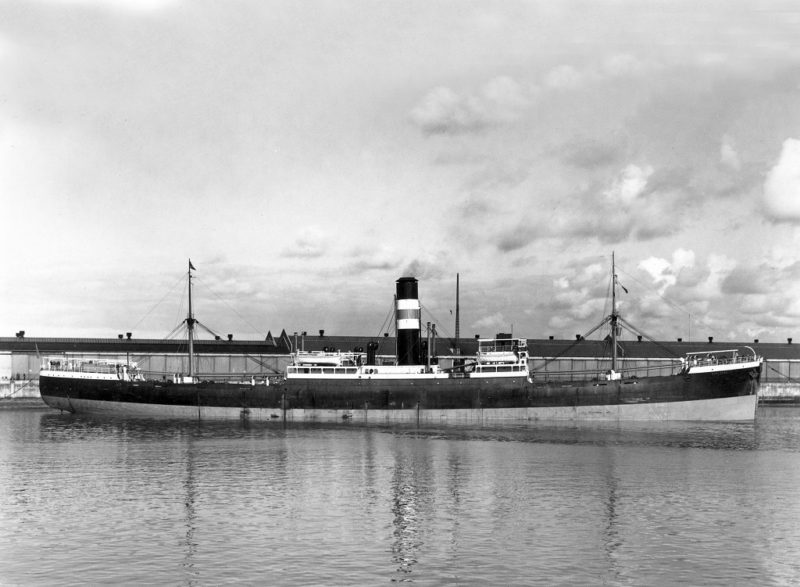
The marriage in 1812 between James Harrison, farmer and landowner, and Ann Hodgson at Cockerham in Lancashire produced six sons and two daughters. Five of the sons survived into adulthood, named Richard Harrison (1813-1862), Thomas Harrison (1815-1888), John Harrison (1819-1867), James Harrison (1821-1891), and Edward Hodgson Harrison (1825-1907). Thomas Harrison in 1830 and James Harrison in 1838 joined George Brown & Company, a busy firm of ship’s agents, charterers and owners of a dozen sailing ships on the 64th principle in King Street in Liverpool, with the main trade being brandy and wines from the Charente area of Bordeaux for brandy merchants Hennessy and Martell. The owner of the business died in 1853, and on 1st July 1853 after negotiations with the deceased family trustees, the Harrison family took over the business under the style of Thos. & Jas. Harrison to manage the fleet and continue the investment in sailing ships that all five of the Harrison brothers had made. Many of the sailing ships were owned by Thomas Harrison (22 shares), James Harrison (20 shares), Edward Harrison (8 shares), Richard Harrison (4 shares), John Harrison (4 shares), with the remaining six shares owned by a co-partner resident in Tonnay Charente, Richard P. Williamson.
The Harrison fleet of Liverpool soon grew into one of the largest privately owned fleets in the world, with cargo-liners engaged on many worldwide trade routes. The first steamers came into service in 1860 and later their tall vertical cowl topped funnels and a red and white houseflag taken from the Knights Templar were seen on all of the oceans of the world. The first services were from Liverpool and London to Calcutta, New Orleans, Galveston, Bahamas and Caribbean islands such as Jamaica, Brazil, British Guiana, Venezuela, Curacao, Colombia, Cristobal on the Caribbean side of Panama, Central America, Guatemala, Honduras, Belize, Honduras, Mexico as well as to Red Sea ports, Indian ports, East and South African ports with a regular cargo of railway lines from Middlesbrough.
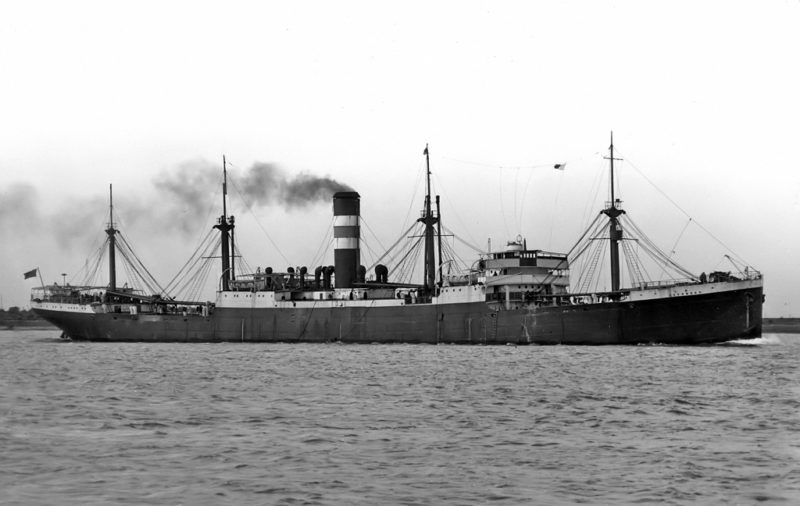
THE ORGANISATION of the HARRISON OCEAN TRADES
The Liverpool shipping company that Thomas and James Harrison had joined in their youth, and in which they had become partners, used single voyage charters or tramping with no continuity or regularity of trading. Thomas and James Harrison planned to change this by a series of advertisements written in 1862 and timed to start in 1863 to give multiple sailing dates to a particular trade area. Shippers and cargo brokers could then plan the intake of cargo some time ahead of sailing day on a regular basis. The new regular voyages were to be made by sailing ships and a series of new steamers that could match the required voyage times with no delays due to adverse wind conditions. The steamers Olinda of 653 grt and Amazon of 673 grt were completed at Hull and Stockton in early 1865 for Thos. & Jas. Harrison, and a larger steamer Fire Queen of 1,164 grt was purchased in early 1866. She had been launched on 1st October 1864 at Hartlepool for the West Hartlepool Steam Navigation Company for regular North Sea liner services, and was to be used by Harrisons on several of the following trades:-
COTTON and GRAIN from GALVESTON and NEW ORLEANS
These were very important trades for Harrisons that were just starting to become established again in 1866 after five disruptive years of the American Civil War. The regular service was a great success with large tonnages of heavy grain placed at the bottom of the holds and lightweight bales of cotton further up and in the shelter decks to give the right amount of deadweight carried at a constant speed. Harrisons, as with all of the new breed of British liner shipowners, relied on good agents at the loading ports in securing large amounts of cargo from their competitors in the same trades. Lucas E. Moore & Company and later Deacon, Zerega & Company at New Orleans, and William Parr & Company at Galveston were good agents for Harrisons, but the trade was so vast that a permanent direct representative from Head Office in Liverpool was stationed at New Orleans for many decades in Alfred Le Blanc Smith. Coastal cargoes of fruit from Belize were later carried to New Orleans for onward shipment by Harrisons.
The new steamer Fire Queen returned to Liverpool on 18th September 1866 after the first successful round voyage on the route. A large fleet of sailing ships was used by Harrisons in the 36 years of trading from 1853 when the Harrison brothers secured control of the company, up to the time that the last sailing ship, Senator, was sold in 1889. Governor, Explorer, Legislator and Engineer were used on this route from 1892 to 1894, and as the volume of cotton cargoes increased new ships such as those of the Magician and Craftsman classes were added to the route. The biggest steamers of around 10,000 dwt were needed on the U.S. Gulf grain and cotton trades, and 19 ships of this size entered service between 1895 and 1912 named Statesman (2), Craftsman, Workman, Historian (2), Collegian, Politician, Tactician, Patrician, Yeoman, Mechanician, Custodian, Civilian, Chancellor, Wayfarer, Huntsman, Explorer (2), Inventor (2), Botanist (2), and Diplomat. These were big six hold four masted ships with dimensions up to overall lengths of 505 feet, moulded beams up to 60 feet, and a loaded draft of 29.0 feet, and powered by triple expansion steam engines or steam turbines. There were two floating heavy lift derricks of 50 ton capacity at Galveston.
The permanent company representative at New Orleans was instructed to make arrangements with all three railroad companies operating into New Orleans to lift between 425,000 and 500,000 bales of cotton per year for the Harrison trade alone, with Elder Dempster and the West India and Pacific Steamship Company, later part of Leyland Line until sold to J.P. Morgan of International Mercantile Marine (IMM), also lifting similar amounts of cotton. Harrisons were in the fortunate position of being able to divert their large steamers to the South African Outward Conference route from 1902, so that when the U.S. Gulf cotton trade was slack some of their vessels were switched to a destination of Cape Town and other South African ports up to Durban.
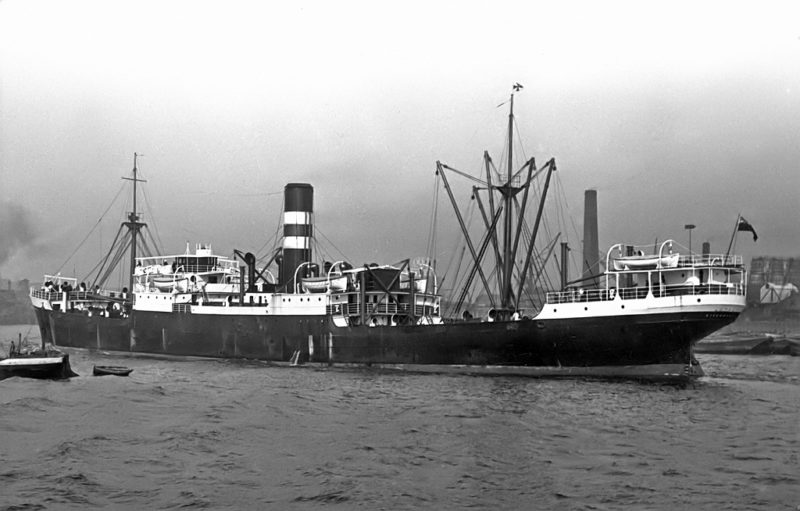
INDIAN and CALCUTTA TRADES
At least a dozen long voyages were made to the Far East by the early sailing ships of the company e.g. Templar of 566 grt made several voyages to India from 1847 until her loss in the Bay of Maranham in Brazil on 27th November 1855 en-route to India. There were a dozen sailing ships in the fleet when the ubiquitous Admiral Grenfell of 324 grt made several voyages to China during 1857/58 after her purchase by Thomas and James Harrison in 1854 and before her sale after the Chinese voyages. However, it was the calls at Calcutta and Bombay for cloves, spices and pepper that seemed the most lucrative. The sailing ship Philosopher of 1,329 grt was purchased in 1857 as the first iron ship in the fleet and also the first ship to bear the name of a trade or profession. She traded to India throughout her career until she was wrecked on 26th September 1879 only a few hours after sailing from Calcutta. The sailing ships Botanist, Geologist, Astronomer, Naturalist, Philosopher and Artist used the long route to India via South Africa between 1865 and 1869 with just over a dozen calls per year. The opening of the Suez Canal in 1869 and the sailing from Liverpool of Fire Queen on 13th January 1870, followed by the steamers Cordova and Alice in February 1870, Statesman in March 1870, Chrysolite in April 1870 and Olinda and Historian in May 1870 produced year end figures of over 50 voyages on the Indian route in 1870 rising to 90 voyages in 1871. The average number of Harrison voyages on the Indian route over the 15 year period from 1870 to 1885 was 40 per year, but there were considerable fluctuations on this route. Thomas and James Harrison had held meetings with Ferdinand de Lesseps of France, designer of the Suez Canal, during its construction, and Fire Queen made the 27th transit of the canal. Speed was also an essential on the Indian route, with the second outward voyage of Historian in 1870 from Liverpool to Calcutta taking only 27 days when she put into Colombo and her Master was commended for her alacrity.
Harrison vessels of up to 9,000 dwt were later required for the Indian trades, whereas smaller vessels of 7,600 dwt were required on the West Indies, Mexico and Brazil routes, and vessels of 6,000 dwt for the other trades. The Harrison agents in Calcutta were Peel, Bellaine & Company (later Peel, Jacobs & Company), and those in Bombay were W. & A. Graham. Cargoes consisted of cloves, spices, pepper, rice, sugar, linseed, poppyseed, tealseed, hides and jute, and the correct stowage of these vastly different weighted cargoes was essential in the holds and shelter decks. A trade in gunny bags was begun in 1906 from Calcutta to the Plate in conjunction with Ellerman Line, Clan Line and Andrew Weir.
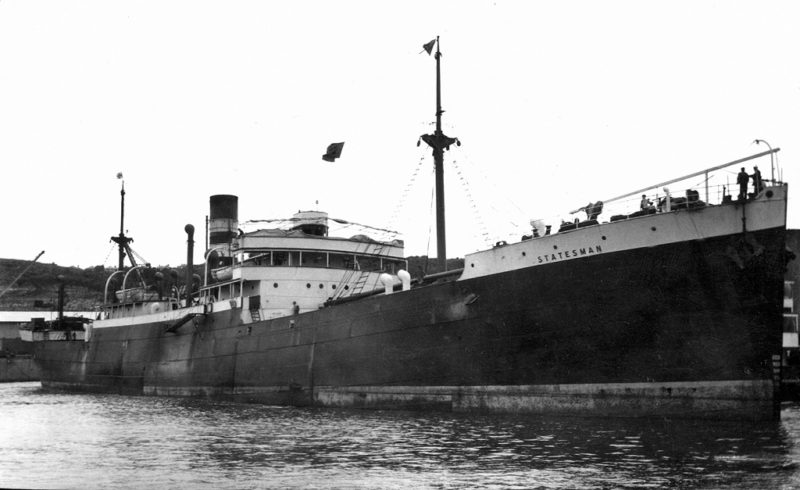
The Calcutta Conference was established in 1875 as the first Conference of groups of shipowners in the world, and ultimately of contractual relationships between shipowners and shippers and merchants ever since. Harrisons were allowed to send a ship to Calcutta every twelve days, making an aggregate of 30 voyages per year. The other early members of this first ever Conference were Clan Line, Anchor Line, T. & J. Brocklebank, Gosman & Smith, and several European shipping lines. The Calcutta Conference was of such importance that out of it grew the Far East Freight Conference (FEFC), which regulated the shipping lines that could trade to India and the Far East.
WEST INDIES, MEXICO and BRAZIL TRADES
The ubiquitous sailing ship Admiral Grenfell of 324 grt and the sailing ship Jane of 113 grt made several extended voyages in the 1840s from Spain and the Iberian peninsula to many parts of the Caribbean and Northern Brazil for sugar, cotton, coffee, tanning materials and island vegetables, fruit and other produce. Harrison sailing ships had made fairly regular voyages from 1847 to Pernambuco and Maranham, it was deemed desirable to link Liverpool and the ports in Latin America, the Caribbean and Pernambuco in Northern Brazil by regular Harrison vessels in the early 1870s. Four separate voyage areas were identified:-
- Barbados, Trinidad and ports along the North coast of South America and Latin America and Mexico
- Kingston (Jamaica) and Belize and British Honduras
- A direct service between Liverpool and Pernambuco
- An overland service via the railroad of the Panama Rail Company across the Panama peninsula of goods transhipped at Cristobal on the Caribbean side, and reloaded at Panama City on the Pacific side for South, Central and North Pacific ports
The Pernambuco trade was made into a regular one in 1864 when inaugurated by Gladiator of 591 grt, followed by Olinda of 654 grt. As was always necessary, good loading agents for the homeward trade were essential, and the Saunders Brothers & Company agency at Pernambuco was considered to be ripe for reorganisation after 20 years of full homeward cargoes of sugar and cotton. The Liverpool manager of Harrisons, William Blackburn, was sent out in 1887 to have full power of attorney for control of greater financial resources of the rapidly expanding Brazilian trades. A new agency of Blackburn, Needham & Company was created and continued to serve Harrison interests until 22nd September 1890 when it expired and was not renewed. Blackburn then invited the local manager Julius Von Sohsten to become a partner in the company on a 60/40 per cent profit sharing basis. The title of Blackburn, Needham & Company was to continue in business, and William Blackburn returned home to Liverpool.
The Pernambuco trade later turned into the lucrative trade of brown Demerara sugar homewards from British Guiana, with William Smith & Company as the Demerara agents for loading copious amounts of brown sugar, some of which was refined into white sugar after arrival in the U.K. by refiners such as Tate & Lyle Ltd. Scruttons, whose ships were taken over in 1920, and Henry Langridge & Company, were both company agents for the British West Indies islands, while Maduro & Sons were the company agents for Dutch islands of Curacao, Aruba, Bonaire and St. Maarten. Councellor of 1903 was a frequent visitor to Curacao before her loss on 14th September 1916 when mined off Galley Head in Northern Ireland inbound from San Francisco via Panama.

SOUTH AFRICAN TRADES
The South African Conference was founded in 1883 by seven lines offering services from the U.K. by Union Line, Castle Line, Bullard King & Company Natal ‘Direct’ Line, Rennie & Sons Aberdeen ‘Direct Line’, Clan Line, South African Line and Imperial Line. Harrisons joined the South African Outward Conference in May 1902, the aim of which was to allow greater flexibility to switch the Harrison ships from the cotton trade of Galveston and New Orleans and other ports in the Gulf of Mexico. Harrisons, in fact, chose to increase their strength on joining by entering into an agreement with John Reeves Ellerman to run a joint service to Cape Town as Harrison-Ellerman Line. Harrison steamers would then tramp with coal or salt up the Indian Ocean to load homewards on the Calcutta Conference. As Clan Line was also closely identified with the Calcutta trade, and the fact that Harrison-Ellerman Line ships carried an average of 5,800 tons of cargo on each voyage while a much smaller size of ship was put on the trade by Clan Line, a certain amount of pooling was allowed. In the year from May 1902, Clan Line and Harrison-Ellerman Line took 108 sailings outwards to South Africa, of which Clan Line took 78, and Hall Line of Ellerman and Harrisons 15 sailings each. Houston Line joined in 1904, and later the German East African Line and the German Australian Line, both of the latter only sailing from Continental ports.
The members of the South African Outward Conference and also of the South African Coastal Conference were by no means as united together as the members of the tighter Calcutta Conference. Harrisons mainly shipped iron, steel, lengths of railway lines and engineering products outwards, with the large amount of exported general cargo from London and railway lines from Middlesbrough creating separate voyage quoting from U.K. West Coast ports and U.K. East Coast ports.
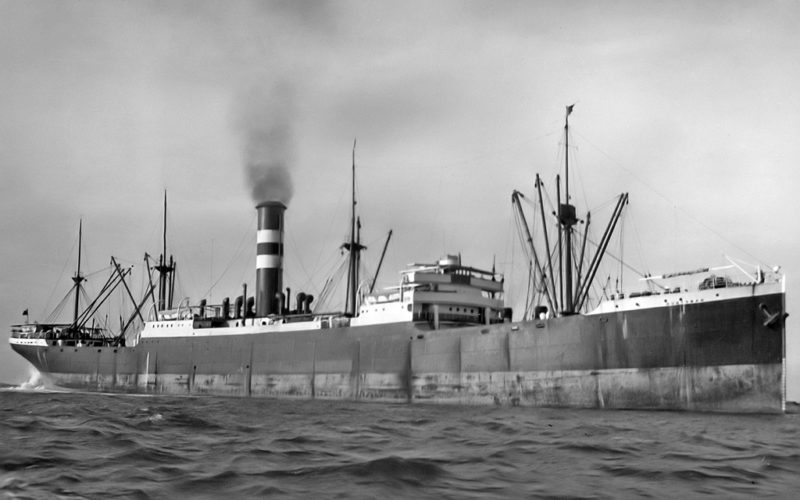
The carriage of steam coal from South Wales for the locomotives of South African Railways was a case in point, when in 1906 Houstons and Rennies declined to join in the sharing of coal cargoes among members. The carriage of flour to South African ports from British ports was a whole pound per tonne more expensive than from American ports, and Harrisons and Ellermans were disposed to agree to the millers’ requests for cheaper rates, whereas Union-Castle Line and Bucknall Line were not. Evidence was made to the Royal Commission on Shipping Rings in session, and rates were eventually reduced.
Members were totally united when tramp shipowners tried to muscle in on Conference cargoes, an example being when Maclay & McIntyre of Glasgow tried to carry 5,000 tons of creosoted railway sleepers from Ardrossan to Durban for the steel firm of Christie & Company. The Glasgow tramping company and the shipper approached the Conference and were quoted Conference rates that were not acceptable to the shipper. Harrisons pointed out that if they carried the sleepers at cheaper rates, this would be a breach of agreements between the South African Government and the Conference.
The sleepers were eventually shipped into Natal from Australian ports. A further larger contract for 75,000 tons of creosoted railway sleepers was awarded to Maclay & McIntyre from Christies in the following year of 1907, and it went the same way, with Christies accepting the inevitable and the large shipment was made in Conference vessels, sustaining the power of the Conference.
One tramp owner, Sir Robert Thomas of the William Thomas Shipping Company and managed in Holyhead, successfully traded his ships to South Africa by undercutting Conference rates for three years between 1927 and 1930 until he landed up in bankruptcy court in 1930.
The John T. Rennie passenger and cargo service to South Africa was purchased in 1911 by Harrisons together with their seven ships of Inanda, Ingeli, Inkonka, Inkosi, Insizwa, Intaba and Inyati, all Zulu names of which Inanda and Intaba were passenger ships. The Harrison-Rennie Line became an important part of Harrison history when three of the Harrison-Rennie Line ships were switched in 1921 from the Natal run to the London to West Indies passenger service of Harrison. The final passenger liner voyage from Durban and Cape Town to the U.K. was made by Intaba on 21st May 1921.
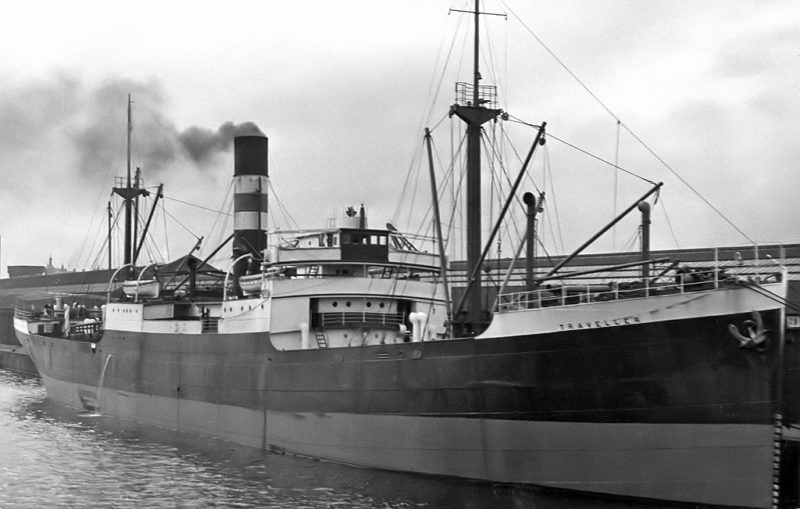
MEDITERRANEAN and EAST AFRICAN TRADES
The brandy trade from Tonnay Charente into both Liverpool and London was extended to take in wine shipments from both Lisbon and Cadiz. The structure of the brandy trade in the early days of Harrisons was very simple with coal and iron products being shipped from Liverpool, Whitehaven, North Shields, and Ardrossan outwards, and homewards with brandy from Charente and fine wines from Lisbon and Cadiz. It was a natural step for this trade to be extended further to Spanish and Italian Mediterranean ports to carry fruit, with 16 calls made at Cadiz in 1865 and onward calls at Malaga, Cartagena, Tarragona, Villa Real and Pomeron. This trade was quite successful for over a decade from 1865 until the Spanish Government stepped in and put a stop to it. The Harrison brandy trade from Charente ended in 1935 with the sale of Cognac (2) of 1,200 dwt and built in 1902 by Connell of Scotstoun on the Clyde. The Harrison trade continued on for a further eight months by the charter of Ardgarroch of P. McAllum & Sons of Greenock and then by space charters on Moss Hutchison vessels.
Traveller of 2,966 grt and built in 1888 was the first ship to trade to East African ports in June 1910. This was a new opportunity to begin a service from Liverpool and Glasgow with British exports of fine cloth, general goods, machinery and engineering products to Kilindini (Mombasa), Zanzibar, Pemba and Tanganyikan ports after agreement had been reaching with the German lines serving this coast, Woermann Line and German East Africa Line. The South African Outward Conference partners of Clan Line and Hall Line also agreed to a joint service operated by the three British liner companies. Calls were also made at Port Sudan on the Red Sea outwards, and on the homeward voyage at Dunkirk, with this important service continuing all the way through the 20th century, ending as the ‘Beacon’ consortium service. South African trading vessels on discharge at Durban could head north and load high freight value copper at Beira or large cargoes and quantities of sisal at East African ports before sailing homeward via Suez.
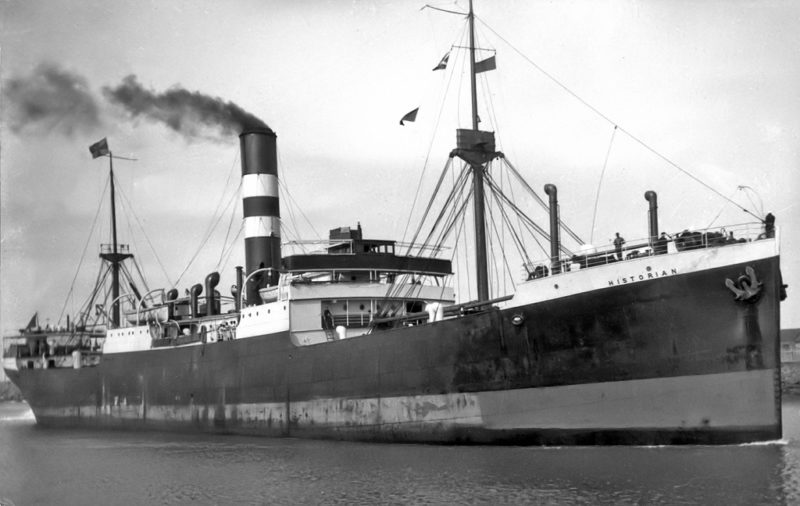
NORTH PACIFIC WEST COAST U.S.A./CANADA TRADES
After the death of Thomas Harrison in 1888, he was replaced as a partner by his son Thomas Fenwick Harrison, and similarly after the death of James Harrison in 1891, he was replaced by his sons Frederick James Harrison and Heath Harrison. The Hughes family were subscribers to the Charente Steamship Co. Ltd. in December 1884 with two of their number among the nine subscribers along with five members of the Harrison family. Thomas Harrison Hughes, later Sir Harrison Hughes, made a Round the World tour in 1910, and agreed to a new trade with Balfour, Williamson & Company, which ran chartered sailing ships from the U.K. and European ports via Cape Horn to North Pacific West Coast U.S.A. and Canada ports. Steamers would now take over, and Harrison ships sailed on a monthly service from Antwerp, London, Liverpool, Glasgow and South Wales ports via the Magellan Strait carrying construction material, cement, general cargo and tinplate on the outward voyage, and canned salmon, canned fruit, dried fruit, grain, lumber and timber on the homeward leg. Calls were at Santos on the outward leg to load coffee for San Francisco, and after the opening of the Suez Canal in 1914, Harrison vessels discharged cargo at Caribbean ports with a final discharge at Cristobal for a ballast voyage through the Panama Canal until the North Pacific service was finally ended in 1933.

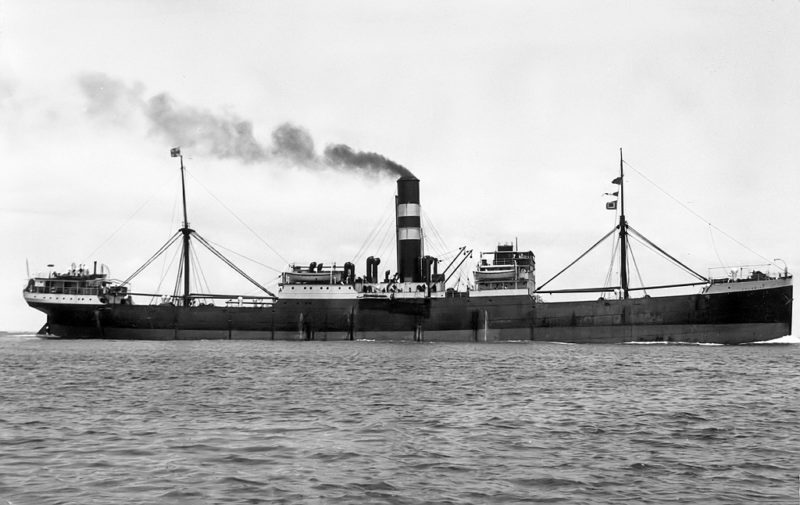
GROWTH OF THE HARRISON FLEET
In 1871, the Harrison fleet owned 28 sailing ships and steamers, the steamers having black funnels with two white bands and one red band, known to seafarers as ‘two of fat and one of lean’. The Charente Steamship Company was formed that year with a capital of £144,000 of which the only non Harrison partners were John W. Hughes, who held 3/64ths, and Richard Pierre Williamson with 8/64ths. The voyage profits or losses were pooled and credited to the company, where after deduction of administrative expenses, a dividend was announced for each 64ths share. Thos. & Jas. Harrison became managers and charged a commission for their management services, and this title remained until the end of the 20th century. Wisely, the Harrison brothers moved in 1878 into a new attractive, four storey Head Office in Liverpool named Mersey Chambers in Old Churchyard, which also lasted as the Head Office for Harrisons until the end of the 20th century.
The Harrison fleet in 1884 was one of 22 sailing ships and steamers with the Charente Steamship Company made into limited liability that year, the liability limited to the published capital of the company and not to the wealth of the shareholders. The capital was £512,000 in shares of £1,000 held by nine subscribers, namely Thomas Harrison, Thomas Fenwick Harrison, Frederick J. Harrison, Heath Harrison, Edward Hodgson Harrison, John W. Hughes, Thomas Hughes, Thomas Williamson and Capt. R. R. Williamson. The fleet taken over was Alice, Author, Architect, Astronomer, Cognac, Chrysolite, Chancellor, Counsellor, Discoverer, Engineer, Explorer, Governor, Historian, Inventor, Legislator, Merchant, Mariner, Orator, Professor, Sculptor, Statesman and Warrior. The last sailing ship Senator was sold in 1889, and the fleet had grown to 30 steamers in 1892.
Vessels lost by marine causes had included two dozen ships between 1873 and 1903, an average of a ship lost nearly every year. A London office was opened in 1910 at Dock Office in Billiter Street to look after the affairs of the large number of ships trading to Calcutta. Subsequently, the amount of cargo moving through the London Docks for Harrison often represented a large share of the total Harrison trade. By the outbreak of World War I, the Harrison fleet was a big one of 57 steamers of 297,133 grt, of which 27 steamers were to be lost to enemy action, and the lives of 130 brave seafarers.
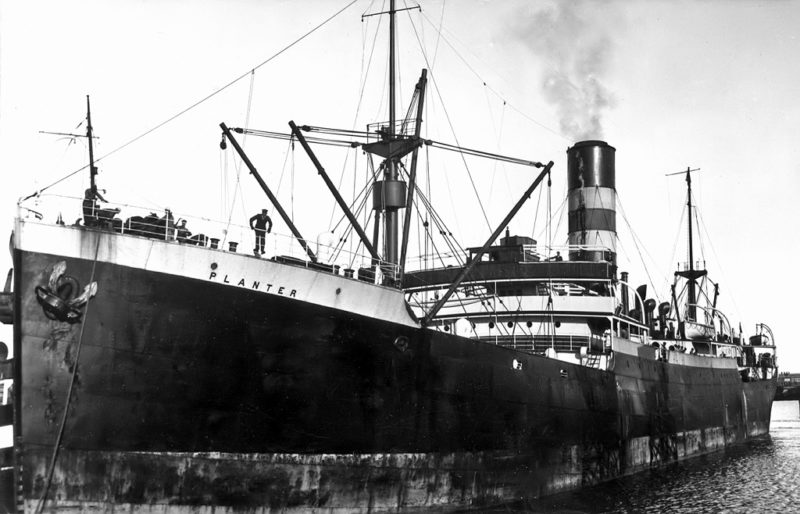
The lost ships were Artist, Author, Barrister (2), Barrister (3), Chancellor, Collegian, Civilian, Comedian, Counsellor, Candidate, Commodore, Centurion, Dictator, Dramatist, Diplomat, Electrician, Gladiator, Governor, Huntsman, Inkosi, Matador, Mechanician, Orator, Spectator, Sculptor (2) , Sculptor (3) and Statesman. Intaba of 4,832 grt and built at Aberdeen in 1910 by Hall, Russell was fitted out as a Q-Ship in 1916/17 and was credited with the sinking of a submarine off the North Russian port of Archangel.
The gaps in the fleet from war losses were filled by the purchase of a dozen ships from the Saint Line in 1917 of Rankin, Gilmour & Company of Liverpool. After filling their concurrent voyages, they were all given traditional Harrison names of professions or occupations. Instructor was the new name of Saint Dunstan in January 1918, but she was lost by collision on 14th July 1918 with the former Hamburg Amerika Line Amerika in the Western Approaches. Amerika had been seized at the start of the war by the U. S. Government, and Instructor was en-route from Portland (U.K.) to Montreal with Government stores, 16 of her 42 crew being lost in the collision.
The Harrison fleet of 49 ships at the end of the war went back to their normal peacetime trading of loading in Brunswick Dock in Liverpool, Morpeth Dock and the East Float in Birkenhead, and the West India Dock and South West India Dock in London. There were now eight partners in Thos. & Jas. Harrison in Sir Heath Harrison, Thomas Harrison Hughes, J. Watson Hughes, Richard Pierre Williamson, John Cecil Mannings, F. A. Baddeley, Eric Danger and Frank Ward. The coal stocks position due to the disruption of colliers during the war had run low and the resultant price of coal rose dramatically. Twelve Harrison ships were converted to oil burning, but the price cycle came back in full circle two years later and all reverted to coal burners.
The fleet was expanded in 1920 by the purchase of eight cargo-liners from the Crown Line of Prentice, Service and Henderson of Glasgow, and they were renamed with ‘C’ names and served the West Indies out of London. Five cargo-liners were also purchased from Scruttons and given ‘S’ names. Dramatist, Diplomat and Huntsman entered service in 1920 powered by steam turbines, but only moderate economies were experienced, and the higher cost of £400,000 and the lack of qualified turbine engineers precluded any further turbine powered ships. At the end of 1921, Harrisons had several laid vessels due to a severe worldwide slump after a post-war boom in 1919/20. Shipbuilders were forced to reduce their prices, and new ships were now only added to the fleet to maintain the pre-war level of trade.

The 1920s gave very poor trading conditions, with the newbuild and retire programme until the end of 1930 being 26 ships retired or sold and 20 ships added to the fleet. New ships included a class of 4 built during 1925/26 as Wayfarer (2), Director (2), Counsellor (4) and Colonial (2), while a class of ten ships was added during 1927/30 as Planter, Rancher, Designer, Custodian (2), Logician (2), Observer, Tactician (2), Comedian (2), Recorder and Contractor. They had elliptical sterns and very tall funnels, with their boilers sending up copious, thick volumes of black smoke high into the air, and the ships would not have been allowed to trade in today’s world of zero emissions.
A six week round voyage Harrison cruise in the winter months of 1932 cost £67 and included calls at Antigua, Barbados, Grenada, Trinidad and Demerara. Competitors calling at Curacao and ports along the coast to the Panama Canal at this time included Royal Mail Line, Leyland Line, K. N. S. M. of Holland, Hamburg Amerika Line, Navigazione Generale Italiana, Horn Line, Gorrisen Line, French Line, Compania Trasatlantica of Barcelona, and La Veloce of Genoa. The Great Depression began with the Wall Street Crash at the start of December 1929, and produced three disastrous years in the liner trades for Harrisons with fifteen ships laid up at Fowey and other ports during 1930 to 1933, and a much reduced fleet of 41 ships in 1932 with ten ships sold for rock bottom scrap prices. In November 1933, the International Mercantile Marine Company set up by J. P. Morgan was forced to sell seven Leyland Line vessels to Harrisons together with the trading goodwill of their Gulf of Mexico routes. The seven became the ‘D’ class of Harrisons with, in addition, Atlantian purchased from Leyland Line in 1934.
In May 1935, four large cargo-liners with six holds and fitted with many derricks on goalpost masts were purchased from Prince Line and renamed Craftsman (3), Collegian (3), Statesman (3) and Politician (2). They were used on the South African trades and had been built for Furness, Withy & Co. Ltd. in 1922/23 by the Haverton Hill yard of the company on Teesside. Politician (2) later achieved notoriety when she was wrecked on the Isle of Eriskay on 3rd February 1941 while en-route from Liverpool to Jamaica and the Gulf of Mexico. She sank into 27 feet of water and her cargo of 275,000 bottles of whisky was extensively looted by the islanders, and was the basis of a book and a film entitled ‘Whisky Galore’.
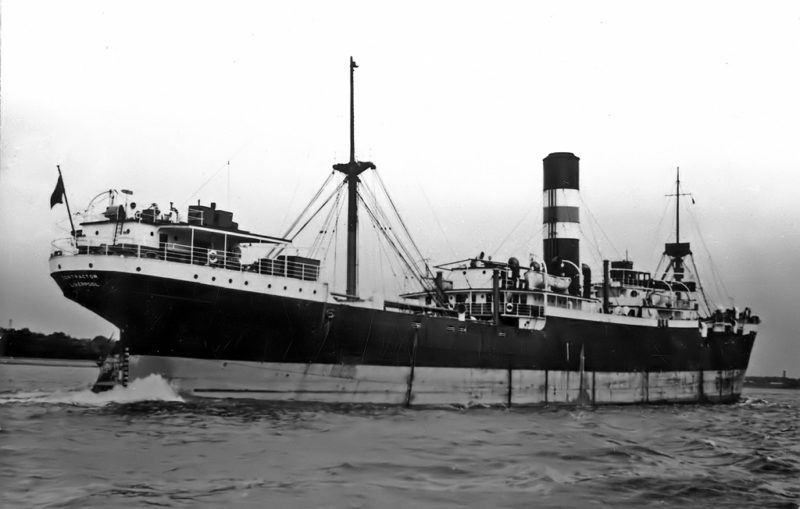
A very cheap purchase due to the prevailing conditions in Depression hit shipyards was made in October 1935 when a ship was purchased off the stocks at Lithgows for only a rock bottom price of £56,000 and was named Merchant. The passenger service to the sunny West Indies had been updated in 1925 by Inanda, costing £177,000 to build, with accommodation for 91 First Class passengers and a crew of 62, and Inkosi in 1937 with accommodation for 82 First Class passengers and a crew of ninety, both from the Wallsend yard of Swan, Hunter & Wigham Richardson Ltd. Service speeds were 13 or 14 knots from quadruple expansion steam engines.
Two final classes were ordered before the onset of World War II, and were completed as a class of four ships of 9,200 dwt during 1935/37 as Inventor (3), Explorer (3), Strategist and Tribesman. The last nine ship ‘Dalesman’ class of 8,820 dwt was completed during 1938/40 as Scientist (2), Barrister (4), Adviser, Settler (2), Dalesman, Novelist, Trader, Prospector and Geologist (2), with Settler (2) the last to be completed before the onset of war.
The Harrison fleet completed 163 round voyages during 1938, with 58% of these to the West Indies, 20% to South Africa, 16% to Calcutta, and the remaining 6% shared between East Africa, Brazil and the U. S. Gulf. Harrison Line steamers during 1939 made eleven calls at Plymouth and landed 65 passengers and 440 bags of mail.
The difficult trading conditions of the inter-war years had been mastered by Harrison managers such as Thomas Harrison Hughes, John Watson Hughes, John Cecil Mannings, Eric Carter Braine (London Manager), Frank Ward, John Cowan, and Eric Danger, the latter in evaluating the alternative turbine and oil engines specifications to the triple and quadruple expansion steam reciprocating engines of the fleet. The Harrison fleet was to decline in size from this point onwards.
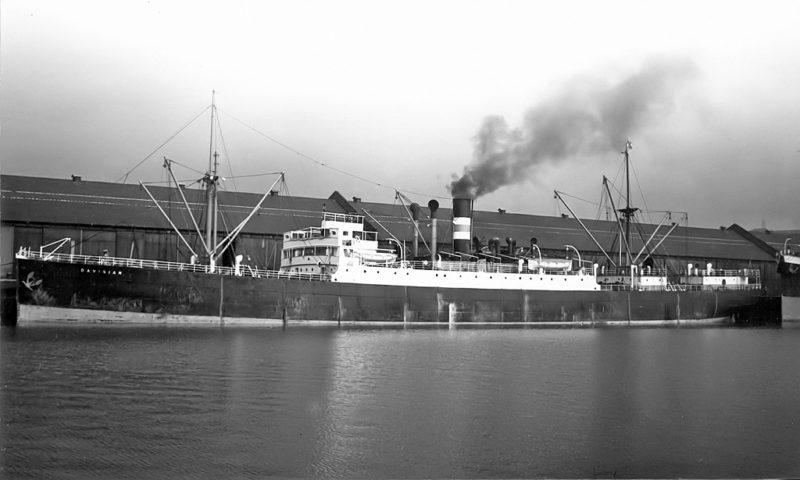
WORLD WAR II
At the outbreak of World War II, the Harrison fleet stood at 46 ships of 280,400 grt, and tragically thirty of these including four by marine hazards were not to survive the conflict.
The company seafarers lost 409 men with 217 taken prisoner and over fifty men were decorated for bravery or were mentioned in dispatches.
Dalesman was sunk by air attack on 14th May 1940 at Suda Bay on Crete with 32 crew taken prisoner and one dying later, and the remaining 24 crew escaped to Egypt with Capt. J. H. Dobson in an abandoned Landing Craft Tank. The Master was awarded the MBE for bravery and navigating such a craft to safety, while Dalesman was refloated by the Germans and used for the carriage of troops and supplies until she was damaged at Trieste by Allied bombers in 1944. At the end of the war, Dalesman was recovered at Trieste and repaired and re-entered Harrison service in November 1946.
Inkosi was damaged during the German air blitz of London Docks on 7th September 1940, and was further damaged two nights later and sank in her dock. She was salvaged and cut down to a freight only ship and put back into service as Empire Chivalry for the Ministry of War Transport. She returned to Harrison service on 30th April 1946 as Planter and gave a dozen more years of service.
Astronomer was torpedoed by U-58 just before midnight on 1st June 1940 having been converted to a boom defence carrier, delivering completed booms to their respective ports. Astronomer lost four crew and a number of naval ratings together with eleven men injured 75 miles north of Kinnaird Head.
Davisian was shelled and sunk by the four inch guns of raider Widder, disguised as the Norwegian ship Narvik, on 10th July 1940 after being captured 420 miles east of Bermuda. One crew member was killed with nine taken prisoner including five injured men after her Master had instructed the radio not be used to signal a raider attack, Widder having begun shelling without regard for the signal. The U boat commander later claimed that he saw men running aft to the rear gun, in fact they were making for a lifeboat. The forty survivors made it safely to Guadeloupe in open boats after four days of sailing.
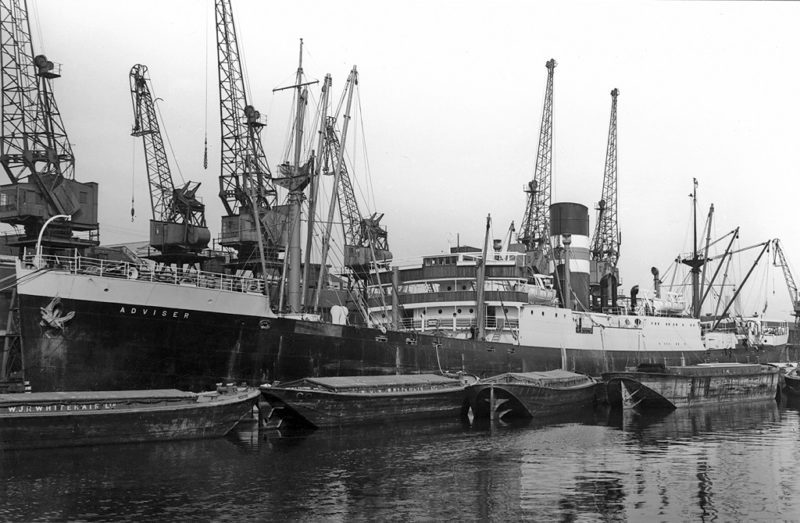
Planter was sunk by torpedo attack by U-137 off the west coast of Ireland on 16th November 1940 with 13 crew killed. The survivors were picked by the destroyer H.M.S. Clare, one of 50 American lend lease warships and landed at Liverpool. Among them were 40 Harrison Lascar seamen, who then embarked on WS5A Convoy Commodore ship Jumna for the Middle East. However, the heavy cruiser Hipper attacked the convoy on Christmas Day, sinking Jumna with the loss of all the Harrison Lascar seamen.
Tribesman was sunk on 1st December 1940, the third Harrison loss in 16 days, by the guns of the pocket battleship Admiral Scheer when 200 miles south west of the Cape Verde Islands on a voyage from Liverpool to Durban and Calcutta. All the lifeboats were launched and two made it safely to the battleship with 76 men, while the other two boats drifted off into the darkness and were never seen again. Tribesmen was repatriating 54 Calcutta seamen and in all 59 lives were lost.
The full list of Harrison Line vessels lost during the war is:-
- Astronomer (3), Auditor,
- Barrister (4), Chancellor (4),
- Counsellor (4), Colonial (2),
- Contractor, Craftsman (3),
- Dalesman, Diplomat (2),
- Director (2), Designer,
- Davisian, Daytonian,
- Huntsman (2), Inanda (2),
- Inkosi (2), Logician (2),
- Magician (2), Merchant (3),
- Observer, Planter,
- Politician (2), Scholar (2),
- Scientist (2),
- Specialist, Statesman (4),
- Traveller (2), Tribesman and Wayfarer (2)
CONTINUED NEXT MONTH


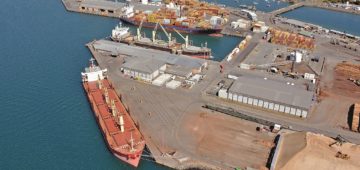



Comments
Sorry, comments are closed for this item